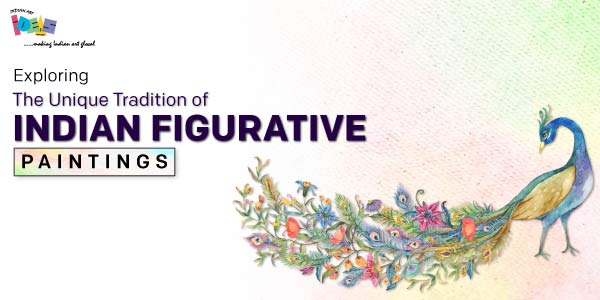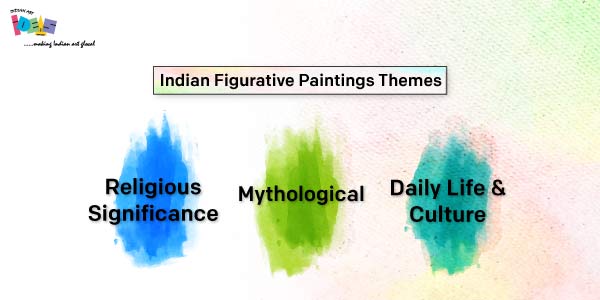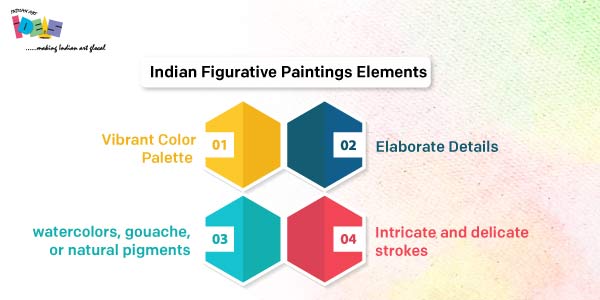
|
Table of Contents 2. Historical Roots of Indian Figurative Paintings - Ancient Origins - Regional Variations - Evolution Over Time 3. Themes and Subjects of Indian Figurative Paintings - Mythological Depictions - Daily Life and Culture - Religious Significance 4. Techniques and Styles of Indian Figurative Paintings - Vibrant Color Palette - Intricate Details - Brushwork and Mediums 5. Modern Interpretations and Contemporary Artists - Contemporary Revival - New Perspectives - Global Impact 6. Final Thought
|
"Art has the power to transcend time and culture, weaving stories that resonate through generations."
In the world of art, Indian Figurative Paintings stand as a testament to the rich and diverse tapestry of India's artistic heritage. These paintings encapsulate the very spirit of India, each stroke and color choice infused with cultural nuances, myths, and narratives. In this blog, we will unravel the captivating world of Indian Figurative Paintings, shedding light on their history, significance, and the unique stories they tell. So, prepare to embark on a visual and intellectual adventure as we uncover the hidden gems within the canvas of India's artistic heritage.
Historical Roots of Indian Figurative Paintings
Figurative Paintings hold a cherished place within India's cultural legacy. They serve as portals to bygone eras, granting us a unique vantage point to peer into the intricate mosaic of history, culture, and artistic brilliance that has thrived across the Indian subcontinent for thousands of years. Each corner of India has nurtured its own unique style and interpretation of figurative art. From the vivid hues of Rajput paintings to the intricate details of Mughal miniatures, the diversity within this tradition is truly astounding. Throughout the ages, this art form has displayed remarkable adaptability, undergoing transformations and evolving in harmony with the ever-shifting socio-cultural dynamics of India. These paintings have endured and thrived, transcending epochs from medieval rebirths to contemporary reinterpretations. They serve as a poignant testament to the enduring artistic resilience and unwavering creative spirit that defines India's cultural heritage.
Ancient Origins
The origins of Indian Figurative Paintings extend far back into the pages of history, with their roots firmly planted in the distant past. These cherished artworks have their beginnings intertwined with the rich tapestry of India's cultural heritage, dating back to 5th century BC. The origins of Indian Figurative Paintings can be attributed to the illustrious Ajanta and Ellora Caves, where the earliest examples of this tradition can be found. These caves, adorned with intricate paintings, showcase the early mastery of Indian artists in capturing life's essence on rock surfaces.
Regional Variations
One of the captivating aspects of Indian Figurative Paintings lies in their regional diversity. Across the vast expanse of India, different regions have nurtured their own distinct styles and interpretations of figurative art. For instance, the Rajput paintings of Rajasthan are known for their vibrant colors and intricate detailing. Meanwhile, the Mughal school of Indian paintings boasts a fusion of Persian and Indian styles, marked by graceful portraits and exquisite details. In South India, the Tanjore school shines with its use of gold leaf and rich ornamentation. These regional variations in Indian Figurative Paintings testify to India's rich cultural tapestry.
Evolution Over Time
The evolution of Indian Figurative Paintings is a captivating journey through time. These paintings have not remained stagnant; instead, they have transformed and adapted to the changing socio-cultural landscapes of India. In the medieval period, Indian paintings experienced a renaissance with the Mughal Empire, with artists like Akbar's court painter, Basawan, bringing new dimensions to the art form. Over time, the fusion of various cultural influences, including Persian and European styles, enriched the tradition. During the British colonial era, Indian Figurative Paintings saw a shift towards more naturalistic portrayals.
In the modern era, artists like Raja Ravi Varma revolutionized Indian paintings with their realism and portrayal of Indian mythology. Today, Indian Figurative Paintings have embraced contemporary themes and mediums, reflecting the dynamic nature of Indian art.
Themes and Subjects of Indian Figurative Paintings

In Indian Figurative Paintings, the canvas becomes a storyteller, weaving tales of culture, beliefs, and life. These paintings delve into a rich tapestry of themes and subjects that give them their unique identity.
Mythological Depictions
Indian Figurative Paintings are often adorned with mythological depictions that breathe life into ancient tales and legends. Mythology occupies a unique and cherished position within Indian art, and these paintings are no different.
These artworks transport us to a realm where gods and goddesses come to life on the canvas. Vibrant colors and intricate details portray Hindu, Buddhist, and Jain mythology epic stories. You'll find gods like Lord Krishna, Lord Shiva, and Goddess Durga, along with celestial beings, all beautifully rendered.
These mythological depictions serve a dual purpose - they entertain and educate. They connect viewers with India's rich spiritual heritage while offering a visual feast for the eyes. In Indian Figurative Paintings, mythology is a vivid thread that stitches the past and present together.
Daily Life and Culture
Another compelling theme in Indian Figurative Paintings is the reflection of daily life and cultural practices. These paintings serve as windows into the past, providing glimpses of a bygone era.
From bustling marketplaces to serene village scenes, these artworks capture the essence of everyday life in India. You'll witness artisans at work, women in traditional attire, and festivities in full swing. Through the strokes of a brush, these paintings preserve traditions and customs that have shaped Indian society for centuries.
The meticulousness in capturing details is truly remarkable. Each nuance of daily existence, from the artistry of cooking meals to the solemnity of religious rituals, finds its expression on the canvas. It's akin to a journey through the annals of history, where you can witness the magnificence of Indian culture as perceived by the artist.
Religious Significance
Religion is the heartbeat of many Indian Figurative Paintings. These artworks are not just aesthetically pleasing but deeply rooted in spiritual beliefs and practices.
Religious significance infuses these paintings with a sense of devotion and reverence. They often depict scenes from sacred texts, temples, and ceremonies. These artworks become a medium for the expression of faith.
Whether it's the depiction of a divine cosmic dance or a meditating ascetic, religious themes in Indian Figurative Paintings remind us of the profound connection between art and spirituality. They invite viewers to contemplate the mysteries of existence and the role of faith in shaping culture and identity.
Indian Figurative Paintings, an art form steeped in history and tradition, captivate art enthusiasts worldwide with their vibrant colors, intricate details, and unique brushwork techniques.
Vibrant Color Palette
One of the most striking features of Indian Figurative Paintings is their vibrant and diverse color palette. These paintings often employ a rich spectrum of colors, reflecting the kaleidoscope of emotions, stories, and cultural nuances they aim to convey.
In Indian Figurative Paintings, colors are not just hues but a language. They symbolize emotions, traditions, and the very essence of the depicted scenes. For instance, deep blues may represent the divine, while lush greens evoke the serenity of nature. The use of red signifies passion and love, while gold and silver leaves bring a touch of luxury to religious or mythological depictions.
Artists meticulously select colors to evoke a specific mood or narrative in their figurative paintings. This unique approach to color adds depth and vibrancy to each piece, making it a feast for the eyes and the soul.
Intricate Details
Indian Figurative Paintings are renowned for their meticulous attention to detail. Artists devote painstaking efforts to capturing every nuance, whether the folds of clothing, expressions on faces, or intricate jewelry adorning the subjects.
These intricate details serve as a window into the portrayed world, allowing viewers to immerse themselves fully in the narrative. The precision and dedication to detailing in Indian Figurative Paintings ensure that each stroke contributes to the storytelling, revealing cultural traditions, historical events, or mythological tales with unparalleled clarity.
Brushwork and Mediums
The techniques and tools artists employ in Indian Figurative Paintings are a testament to their craftsmanship and skill. Traditional paintings often utilize a variety of mediums, such as watercolors, gouache, or natural pigments, each carefully chosen for its texture and vibrancy.
The brushwork in Indian paintings is distinctive, marked by intricate and delicate strokes that require precision and finesse. Artists may use fine brushes for intricate details and broader strokes to create bold outlines. Using natural and handcrafted brushes contributes to these artworks' unique textures and effects.
Furthermore, many Indian painters employ techniques like "miniature painting," characterized by highly detailed, small-scale works. This intricate approach allows for creating intricate compositions even on compact canvases.

Read More: 5 Indian Figurative Painting Makers that will make you Love your Body
Modern Interpretations and Contemporary Artists
In the ever-evolving art world, Indian Figurative Paintings have not remained static relics of the past. They have transformed remarkably in the modern era, breathing new life into an ancient tradition.
Contemporary Revival
Indian Figurative Paintings have experienced a renaissance in the modern era. Contemporary artists have revived this artistic tradition with a fresh perspective. They have embraced both traditional methods and modern mediums, skillfully blending them to create a fusion that resonates with a diverse and extensive audience.
Contemporary artists frequently find their creative wellspring in India's abundant history and culture, seamlessly blending these profound influences with contemporary themes and sensibilities. The resurgence of figurative paintings doesn't merely represent a nostalgic retreat to bygone eras; instead, it serves as a vibrant celebration of the enduring significance of these artworks in the context of our modern world.
New Perspectives
Contemporary artists are not merely replicating the past but reinterpreting traditional themes in innovative ways. They approach Indian Figurative Paintings with a critical eye, questioning societal norms and challenging conventions. This infusion of new perspectives breathes life into age-old narratives.
For example, modern-day artists often employ symbolism to address urgent societal concerns or delve into the convergence of age-old traditions with contemporary realities. Through this approach, they effectively connect the historical narratives of the past and the current dynamics of the present. Thus ensuring that these paintings remain pertinent and relatable to today's audiences.
Global Impact
The influence of modern Indian figurative artists extends far beyond national borders. Their works have garnered international recognition, contributing to the global art discourse. These artists have been featured in prestigious exhibitions and galleries worldwide, showcasing the universal appeal of Indian Figurative Paintings.
Furthermore, their art often serves as a bridge between cultures, fostering cross-cultural understanding and appreciation. Through their innovative approaches and unique interpretations, contemporary Indian figurative artists leave an indelible mark on the global art scene.
Final Thought
Indian Figurative Paintings are a testament to India's rich cultural heritage, weaving tales of mythology, daily life, and spirituality on vibrant canvases. Over centuries, these artworks have undergone a transformative journey, adjusting to the shifting tides of time while safeguarding the essence of tradition.
In our interconnected global society, the significance of these paintings extends beyond their aesthetic appeal; they serve as cultural emissaries. They effectively link historical narratives and contemporary realities, granting us a glimpse into India's rich tapestry of history and beliefs. Additionally, contemporary artists have breathed new life into this tradition, injecting it with innovative viewpoints that strike a chord with today's audience.
For those seeking to explore or acquire these magnificent artworks, Indian Art Ideas stands as your gateway to the world of Indian Figurative Paintings. Our portfolio offers a curated selection of these timeless masterpieces, allowing you to bring a piece of India's rich artistic heritage into your life. Explore the colors, stories, and traditions encapsulated in these paintings and embark on a journey of cultural discovery.
Interesting Blog: Tracing the Rise and Fall of Figurative Paintings
FAQs
What makes an Indian figurative painting unique?
Indian figurative paintings are unique for their intricate blend of diverse regional styles, vivid symbolism, and the ability to capture the rich cultural tapestry of India, showcasing both tradition and innovation on a single canvas.
What type of art is figurative art?
Figurative art is a form of visual art that represents real-world subjects, often depicting recognizable people, objects, or scenes, emphasizing their physical and tangible qualities.
What are the elements of figurative art?
Figurative art typically represents recognizable objects, people, or subjects, often emphasizing realistic details and human forms to convey emotions, stories, or ideas. Key elements include lifelike proportions, facial expressions, and symbolism to convey meaning.
What is a figurative shape in art?
In art, a figurative shape refers to a recognizable and representative form, often depicting objects, people, or elements from the real world, as opposed to abstract or non-representational shapes.






















